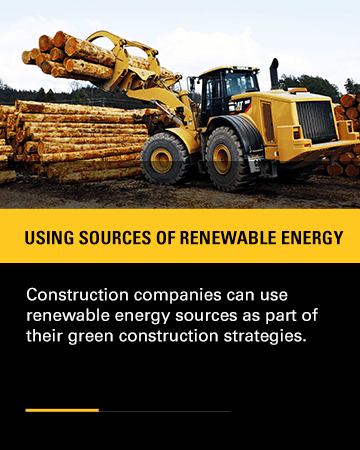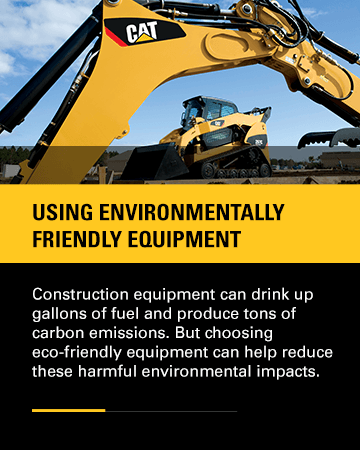
Guide for Implementing Environmentally Friendly Construction Strategies
Pollution and climate change have devastating impacts on the modern world. Across the globe, nine out of every 10 people breathe polluted air, and climate change has the potential to alter the global landscape dramatically and permanently.
Construction projects generate significant amounts of pollution and waste. The U.S. Environmental Protection Agency (EPA) estimates that construction and demolition projects generate approximately 569 million tons of waste every year. But environmentally friendly construction strategies can help reduce waste and curb the emission of pollutants.
What are sustainable construction techniques, why are they important, and what steps can construction businesses take to implement them? We'll answer these questions below.
Jump to a section:
What Is Green Construction?
Green construction refers to practices that promote responsible building, reduce waste and help preserve the environment. Green construction practices can take a variety of forms, but they commonly extend to multiple aspects of the construction process, including design, building, operation, maintenance, renovation and deconstruction.
How to Implement Eco-Friendly Construction Strategies
Some environmentally friendly strategies construction businesses can implement include the following:
1. Improving Overall Health and Safety
Construction business owners and contractors can take several steps to improve overall health and safety on the job site. Using safer, eco-friendly products and safety-conscious protocols is one such step. Consider implementing these products and programs:
- Nontoxic paints, solvents and adhesives: Construction sites can consider using nontoxic paints, solvents and adhesives to protect employee health, consumer health and the environment. Toxic paints, solvents and adhesives often contain volatile organic compounds (VOCs). These harmful compounds cause respiratory distress, headaches, skin rashes and other health concerns, and they can also leach into the surrounding environment and pollute the soil and water. But the nontoxic versions are much easier on the human body and the ecosystem.
- Nontoxic building materials: Construction sites can also use nontoxic building materials like natural lumber, clay plaster and even straw bales. Nontoxic building materials make construction projects safer to work on, the completed buildings safer to live in and the surrounding environment cleaner.
- Prevention Through Design: The National Institute for Occupational Safety and Health (NIOSH), which is part of the Centers for Disease Control and Prevention (CDC), has developed a program called Prevention Through Design. This program aims to prevent occupational injuries, illnesses and fatalities in construction. Part of its strategy includes integrating environmental, energy and sustainability guidelines with occupational health and safety guidelines — for example, by introducing protocols for the safe handling of toxic waste or the reduction of pollutants on construction sites.

2. Improving Demolition Processes
Traditional demolition practices generate tremendous amounts of rubble and waste that tend to pile up in landfills — including materials such as concrete, wood, asphalt, gypsum from drywall, metals, bricks, glass, plastics, trees, stumps and earth. But greener demolition practices can help alleviate this concern. Some improved, environmentally friendly demolition practices companies can adopt include the following:
- Increase recycling: Construction materials such as concrete and steel shouldn't go to landfills when they can still find uses in new construction projects. Construction contractors can send these materials to industrial crushing sites, where heavy-duty equipment crushes them into dry aggregate that can be repurposed for new projects.
- Reuse materials: Ceiling and flooring materials like plastic and vinyl are also ideal for reuse in new projects. Reusing or recycling these materials helps construction companies do their part for the environment and also avoid hefty waste disposal fees.
- Rebuy materials: Alternatively, construction companies can rebuy demolition materials if they cannot reuse their own. Buying materials salvaged from other sites helps reduce waste and promote environmental sustainability.
3. Using Locally Sourced and Alternative Materials
Construction businesses and contractors can also do their part for the environment by using locally sourced and alternative materials. Transporting materials over excessive distances leads to higher fuel consumption and dramatically increases the amount of carbon dioxide emitted into the atmosphere. Buying locally helps reduce both fuel consumption and emissions. And alternative materials help cut down on the release of toxic pollutants.
Here are a few alternative and recycled materials for use in construction projects:
- Bamboo: Bamboo grows much faster than hardwood trees and is a much more rapidly renewable substitute for hardwood.
- Ceiling materials: Slag wool from the steel industry, newspaper, glass and sugar cane can be used in the manufacture of ceiling tiles.
- Cork: Sustainably harvested cork can be used in linoleum.
- Fly ash: Fly ash, a byproduct of coal production, can be used as a filler in cement and concrete. Cement and concrete production is notorious for its resource consumption and greenhouse gas emission, but substituting fly ash makes production more sustainable.
- Insulation materials: Sheep's wool has wonderful insulating properties while containing no toxic chemicals. Cotton from recycled clothing is another reliable solution, as is the use of straw bales. So is wood fiber, which takes the byproducts of the timber industry — wood chips — and compacts them together using natural, nontoxic adhesives.
- Rubber: Recycled rubber and tires can be used to make rubber flooring.
- Vinyl and PVC plastic: Vinyl and PVC plastic can be recycled for use in vinyl flooring.
Using locally sourced and alternative materials is an excellent way to help protect the environment, but it has ancillary benefits for construction companies as well. Using locally sourced materials often means shorter transit times and fewer transportation-related delays in construction. And buying locally helps support the local economy and gives nearby businesses a much-appreciated boost. Those businesses may one day repay the favor by engaging your construction services, extending the benefits all around.

4. Using Sources of Renewable Energy
Construction companies can use renewable energy sources as part of their green construction strategies. Harnessing renewable energy sources can help construction businesses reduce their fossil fuel consumption and make their buildings more energy-efficient.
Harnessing renewable also offers several ancillary benefits. If fuel costs in your area are high, using renewable energy may help your company lower its utility costs. And using alternative forms of energy helps reduce strain on the electrical grid and reduce the risk of blackouts and brownouts, especially in the summer, when electricity costs often soar.
Solar Power
Using solar panels on the roofs of buildings or as standalone panels in yards or gardens helps transform buildings into power generators. In a residential construction project, contractors could install photovoltaic windows that contain solar cells. These windows would be able to adjust their transparency in response to the amount of sunlight they received and help moderate the temperature inside the home.
Using solar power in building construction can provide these benefits:
- Sustainability: Solar energy is entirely sustainable. As long as the sun shines, solar energy will be available for humans to harness and use.
- Reducing water scarcity: Solar energy uses very little water, whereas fossil fuel production guzzles it. Widespread use of solar energy across the United States could help save enough water to hydrate 1.3 million homes.
- Curbing pollution: Fossil fuel extraction, refining and use emits tremendous volumes of pollutants into the atmosphere. Widespread adoption of solar energy technology could curb pollution and help prevent up to $167 billion in adverse health and environmental impacts.
- Mitigating climate change: Climate change is one of the most pressing issues facing the world today. Increased use of solar energy in buildings could reduce our climate footprint and save up to $259 billion in global damages from climate change.
- Improving health and well-being: The health effects of pollution affect many lives. Pollution can cause asthma, other respiratory diseases like bronchitis and emphysema, skin rashes, and even heart disease and strokes. Globally, 7 million deaths every year are attributable to breathing polluted air. Widespread use of solar energy in place of fossil fuel energy could save more than 25,000 lives and improve the quality of life for many more people.

Wind Power
Using the power generated from turbine farms is another way to invest in alternative energy. Construction companies can use wind turbines of any size to help power their buildings. They can partner with large wind farms for energy, or they can install vertical axis or helical wind turbines on the roofs or in the yards of new constructions. These installations help reduce the consumption of fossil fuels, and they also offer the benefit of requiring very little maintenance.
The U.S. Department of Energy lists these advantages of using wind energy instead of fossil fuel energy:
- Sustainability: Like solar energy, wind energy is sustainable energy. Wind arises when the sun's heat combines with the rotation and the surface irregularities of the earth. As long as the sun shines and the earth rotates, wind energy will be available for human use.
- Cost-effectiveness: Wind energy is exceptionally cost-effective. Wind energy is one of the lowest-priced energy sources available today, typically costing between 2 and 6 cents per kilowatt-hour.
- Clean energy: Like solar energy, wind energy is clean energy. Wind energy production emits no greenhouse gases and does not contribute to pollution levels or climate change.
- Domestic sourcing: The U.S. imports many of its fossil fuels, but U.S. wind energy sources are almost entirely domestic. And as new wind farms come online, domestic wind capacities only keep growing. Wind energy is currently the United States' number one domestic source of renewable energy.
- Cooperative opportunities: Wind farms offer collaborative opportunities between energy suppliers and farmers and ranchers, as well as for commercial properties. Wind turbines have tiny footprints, so farmers, ranchers and commercial properties can have them installed with little effect on their businesses. Farmers and ranchers can still work their land, and commercial entities can do business, all while wind turbines generate energy from their properties. In exchange, energy suppliers may pay a rental fee for the use of the land, as is common on farms and ranches. Or businesses may use the energy generated to reduce their dependence on traditional electrical power.

Geothermal Energy
Geothermal energy is less well known than its wind and solar counterparts, but it offers a valuable alternative to fossil fuels as well.
Geothermal energy is the heat energy produced beneath the earth's crust. Reservoirs of hot water lie at various depths beneath the surface of the earth. Water and steam carry this energy to the earth's surface, where it sometimes erupts as geysers or forms bubbling hot springs.
But even where these natural features are not visible at the surface, companies can drill wells a mile deep or more to tap into these valuable reservoirs. Then they harness the subterranean heat and use it for energy in place of traditional fuels.
The U.S. Department of Energy lists the following benefits of geothermal energy:
- Renewability: Subterranean heat reservoirs naturally replenish themselves. So with careful management, energy companies can calibrate their extraction processes to match the natural rate of replenishment. Doing so means the supply of heat energy will never run out as long as the proper management protocols are in place.
- Consistent baseload: Because of this natural replenishment, geothermal heat sources can produce a constant supply of energy — 24 hours a day, seven days a week, in all types of climatic conditions.
- Domestic production: Unlike crude oil, which the U.S. produces but also imports, geothermal energy in the United States is largely domestically sourced. The United States has many geothermal resources that are ideal for use as energy supplies.
- Clean energy: Geothermal energy is clean energy. It releases little to no carbon dioxide into the atmosphere, and its processes consume very little water.
5. Increasing Green Space and Mixed-Use Areas
Construction businesses can also work with land developers to incorporate green space and mixed-use areas into their projects. Incorporating green spaces into construction projects allows vegetation to flourish and increases the amount of carbon dioxide absorbed from the atmosphere. Green spaces can be parks or tree-lined walkways, but they can also include innovative solutions like rooftop or indoor gardens.
Incorporating green spaces helps improve the air quality inside buildings as well — plants act as natural air filters, removing carbon dioxide and pollutants and releasing clean oxygen for a fresher indoor environment.
Mixed-use spaces can also help form part of an eco-friendly construction strategy. Instead of merely building a commercial complex, a construction business could partner with a land developer to create a multipurpose area containing office buildings, parks and tree-lined bike paths. A space like this would help sustain the local ecosystem as well as promote the additional benefits of fitness and community.

6. Using Environmentally Friendly Equipment
Construction equipment can drink up gallons of fuel and produce tons of carbon emissions. But choosing eco-friendly equipment can help reduce these harmful environmental impacts. Look for machinery with low fuel consumption and low emissions, or rent equipment that can use alternative fuels or biodegradable hydraulic oil.
7. Using Green Construction Techniques and Fixtures
A few of the latest trends in eco-friendly construction techniques and installations include the following:
- Zero net energy: A zero-net-energy building is a special type of building that generates an amount of energy equal to the amount it consumes. Buildings typically do this through the addition of solar panels or small wind turbines.
- Climate change resistance: As extreme weather patterns increase with climate change, more construction businesses are partnering with designers on buildings that can withstand severe storms.
- Water conservation: Construction companies can also add features to promote water conservation, such as low-flow toilets and showerheads.
- Smart buildings: Smart buildings use automatic sensors to control temperature, lighting, ventilation and security. They can turn off heating, cooling and lights when rooms are empty.
- Low-emitting windows: Low-emitting windows have a special coating to prevent heat entry in the summer and heat loss in the winter. These efficient windows help reduce energy consumption by keeping rooms comfortable all year round.
- Cool roofs: Cool roofs use specially designed tiles and reflective paints to deflect heat. They help reduce energy use by keeping homes from overheating in the summer.
- Biomimicry: Biomimicry is a technique used to develop construction designs based on nature, such as by using natural materials in adhesives and other construction necessities.

Benefits of Implementing Environmentally Friendly Construction Strategies
Implementing green construction strategies provides several different benefits for construction businesses, consumers and the community.
1. Environmental Benefits
Of course, the environmental benefits that result from green construction practices are the most important. Petroleum generators and leaking pipelines can cause catastrophic environmental damage. And the carbon emissions associated with fossil fuel consumption are well known for their impact on global temperature increases, polar ice cap melting, ocean acidification, increased severe weather patterns and more. Using sustainable energies and practices helps curb these harmful effects and promote a healthy global ecosystem that we and our descendants can enjoy for generations.

2. Lowered Costs
Energy efficiency often goes hand in hand with financial efficiency. Using green construction practices can help lower costs. In the United States, 20% of all the energy used goes toward powering commercial buildings, but greener practices can help low that number. For instance, the U.S. Department of Energy reports that commercial buildings that rely on solar energy use up to 70% less electricity than conventional buildings and provide benefits in the form of reduced utility bills.
3. Job Creation
The green energy sector helps create much-needed jobs across the country. Demand is high for people who have the skills and expertise to design, install and maintain solar panels and wind turbines. And in the future, the green energy sector will only expand. It will need more people to develop innovations in sustainable energy and more people with the skills to keep the new technology running effectively. By incorporating sustainable energy into their construction practices, construction businesses help create job opportunities in their communities and across the United States.

4. Tax Benefits
Implementing eco-friendly construction practices also helps businesses receive tax benefits they can use to boost their savings or grow and develop. Homes and businesses that have incorporated green energy solutions like photovoltaic cells, solar heaters, geothermal energy, small wind farms of or energy-efficient appliances are eligible to collect tax incentives from the U.S. Internal Revenue Service (IRS). These incentives can help encourage companies to incorporate green solutions as part of their business operations.
5. Boosted Reputation
For construction companies, green practices often provide a boost in reputation. More and more, consumers are looking to businesses to demonstrate their values in the way they operate. If businesses don't share their values, consumers are less likely to work with them. But a company that demonstrates genuine care for the well-being of the community and the environment will likely earn clients' respect.
6. Increased Business
When local businesses and residents learn that they can trust a construction company to operate in eco-friendly ways — and provide quality results while doing so — they are more likely to partner with the company for construction services. They are also more likely to engage in word-of-mouth advertising that helps boost the company's reputation even more and allow it to win more and more bids.

Contact Your Local Cat® Dealer for Environmentally Friendly Equipment Solutions
Rent whatever you need from the people who do whatever it takes. That's the Cat® rental motto, and it has served our customers well for years. When you need quality, green equipment for your job site, contact The Cat Rental Store to find eco-friendly machines among our extensive catalog of rental equipment. We are committed to keeping up with the latest trends in green construction and can help you find the solutions you need.
Find a location online, and get in touch today to learn more.
Find The Cat Rental Store Near You

